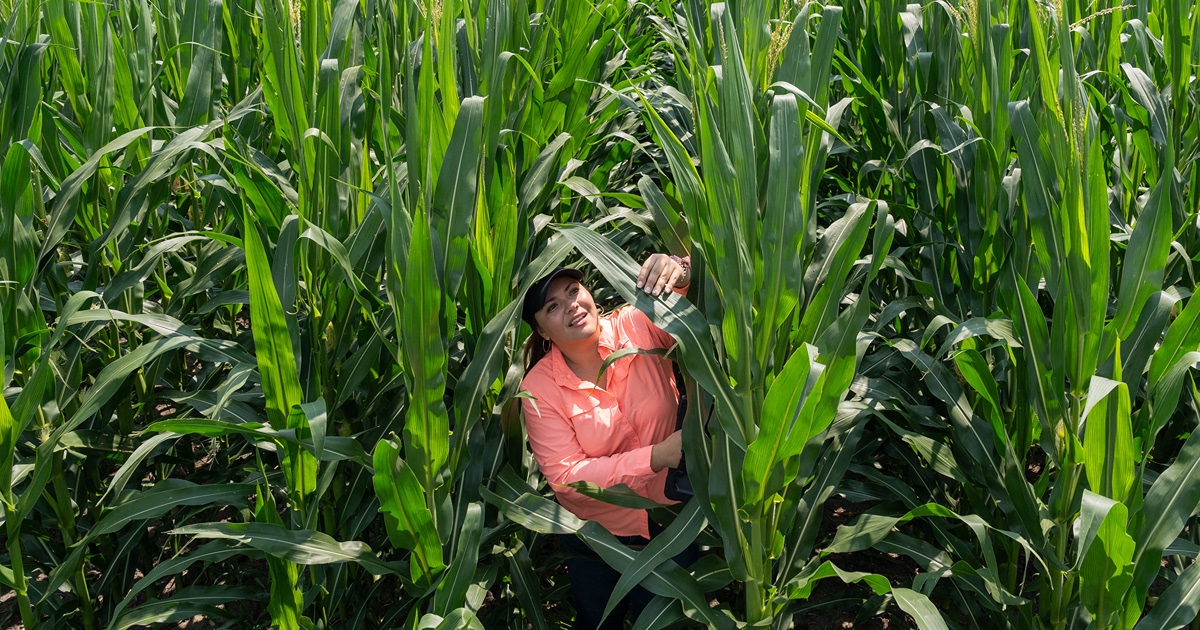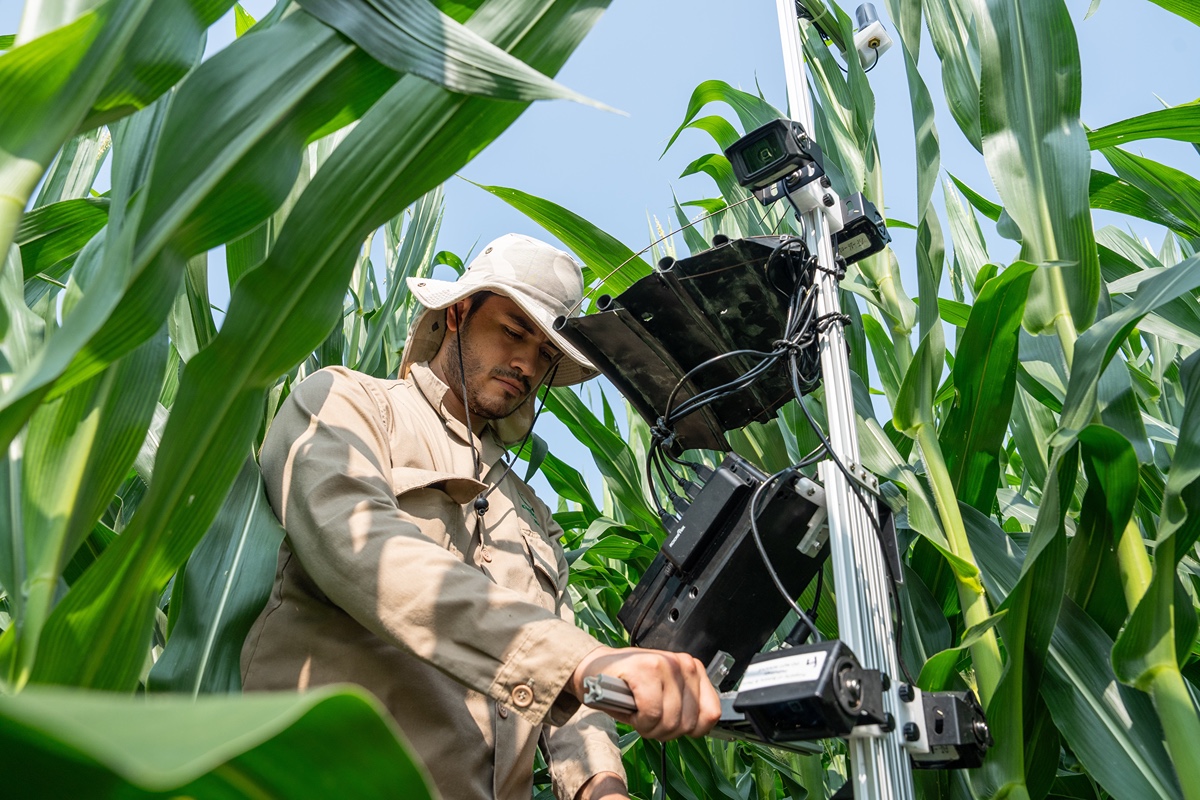West Lafayette, Indiana, USA
August 1, 2024
Mix of agricultural and engineering methods deployed for monitoring and assessment
 Mariela Fernández-Campos, a graduate student in Purdue University’s Department of Botany and Plant Pathology, examines leaves for tar spot in a field at Pinney Purdue Agricultural Center.
Mariela Fernández-Campos, a graduate student in Purdue University’s Department of Botany and Plant Pathology, examines leaves for tar spot in a field at Pinney Purdue Agricultural Center.
For more than a century, tar spot fungal disease in corn kept its distance from the U.S., biding its time.
“Tar spot had not been detected in the U.S. prior to 2015, but it has been endemic in several Latin American countries, starting in Mexico in 1904,” said C.D. Cruz, associate professor of botany and plant pathology at Purdue University.
Tar spot afflicted two of Indiana’s 92 counties in 2015. By 2022, only a few had managed to remain unscathed. At that time, the fungus had extended to 16 states and Ontario, Canada, according to the Pest Information Platform for Extension and Education.
The fungus had also affected crops in 15 other countries in Central and South America, the Caribbean, and the U.S. territories of Puerto Rico and the Virgin Islands, Cruz and co-authors reported in an article published in the journal Plant Disease.
Where did the disease come from, via what pathway, and how different is the pathogen in other countries compared to the U.S.? “Maybe we don’t have those populations here yet, and they could potentially be much more damaging than the ones currently present,” Cruz noted.
Cruz and his associates apply a mix of statistics, data science, epidemiology, microbiology, artificial intelligence, computer vision and continual stakeholder feedback to better understand the dynamics of tar spot in corn. Their work is funded by two grants totaling nearly $1.1 million from the USDA National Institute of Food and Agriculture.
Deploying these methods of high-tech data collection and analysis could make a vital mass of corn pathology information more widely and rapidly available. “There are opportunities in integrating AI-based digital technologies and point-of-care diagnostics that can provide rapid and accurate information for stakeholders,” Cruz said.
 C.D. Cruz, an associate professor in the Department of Botany and Plant Pathology at Purdue University, leads two research projects involving tar spot in corn funded by the USDA National Institute of Food and Agriculture.
C.D. Cruz, an associate professor in the Department of Botany and Plant Pathology at Purdue University, leads two research projects involving tar spot in corn funded by the USDA National Institute of Food and Agriculture.
Colleagues Joaquín Ramirez in Colombia; Carlos Góngora in Mexico; César Falconí in Ecuador; Da-Young Lee in South Korea; and Paul Esker, Steve Goodwin, and Matt Helm in the U.S. are participating collaborators. The need to address biosecurity challenges with a science-based approach lend urgency to their work.
In previous efforts, Cruz and Lee, who was a postdoctoral researcher in Cruz’s lab, developed a digital method for quantifying tar spot in corn. They tested their stromata contouring detection algorithm (SCDA) under field conditions against human raters. They successfully quantified trends, and their results appeared in a 2021 paper published in Frontiers in Plant Science.
Earlier this year, Cruz’s team conducted a similar experiment with SCDA 2.0, again with promising results, but some inaccuracies persist in fully automated scenarios. “We’re refining our training methods to significantly improve the model’s accuracy and performance,” he said.
Another research effort includes the laboratory of Purdue’s Mohammad Jahanshahi, associate professor in the Lyles School of Civil and Construction Engineering and the Elmore Family School of Electrical and Computer Engineering. Jahanshahi and Cruz, together with Mariela Fernández-Campos, a PhD student in botany and plant pathology, and Yu-Ting Huang, a postdoctoral research associate in civil engineering, published the results of their first collaboration in 2021, a special blend of agriculture with engineering that focused on another high-profile fungal disease called wheat blast. The developed model detected and classified images of disease symptoms within two seconds.
Together they are educating the next generation of problem solvers, Jahanshahi said. “Whether you’re working on civil infrastructure health monitoring or agricultural disease epidemiology, you can have a profound impact not only on humans but also on the environment.”
 Emanuel Santos, a visiting scholar in Purdue University’s Department of Botany and Plant Pathology, operates a phenotyping sensor tool developed by a partner robotics company of C.D. Cruz. At the Pinney Purdue Agricultural Center, Santos collects images used for continuously testing and validating the stromata contouring detection algorithm (SCDA).
Emanuel Santos, a visiting scholar in Purdue University’s Department of Botany and Plant Pathology, operates a phenotyping sensor tool developed by a partner robotics company of C.D. Cruz. At the Pinney Purdue Agricultural Center, Santos collects images used for continuously testing and validating the stromata contouring detection algorithm (SCDA).
Previously, Jahanshahi had used robotic systems to monitor civil infrastructure such as roads, bridges, buildings, sewer pipelines and nuclear reactors for damage. But when he began working with Cruz, he realized that structural damage corresponds to disease in wheat and other crops.
Even so, Jahanshahi noted, “You cannot just copy this method and apply it to another domain.” He now has adapted his AI and computer-vision approaches to inspecting and analyzing civil infrastructure damage for agriculture.
Currently, Fernández-Campos and Abhishek Subedi, a PhD student in civil engineering, are finalizing a proof-of-concept data fusion project. They leveraged data collected from previous collaborations with Darcy Telenko, an associate professor of botany and plant pathology.
“In the current digital agricultural revolution, we aim to understand tar spot by using various data types. Unlike traditional models that rely solely on weather information, we are integrating drone imagery and weather data to capture crucial details about the tar spot pathosystem,” Fernández-Campos said.
Jahanshahi and Subedi helped fuse two very different data types: vegetation measures with drone imagery and numerical weather information using AI approaches. Meanwhile, Fernández-Campos used the same data, this time implementing traditional statistical methods for plant pathology.
“We tested our method’s performance against the disease evaluations of human raters,” Subedi said, and they were able to correlate the appearance of the disease and its progress. “We were able to build a strong enough model to detect the tar spot using images taken from a 50-meter height and on-site weather information.”
Another parallel task is to quantify and model tar spot epidemics in production-style fields. Graduate student Brenden Lane from Cruz’s lab and Sungchan Oh, a computational infrastructure specialist in the Institute for Plant Sciences, use disease observations and drone-based imagery to characterize tar spot epidemiological dynamics at various scales. Ultimately, the team aims to quantify and model tar spot severity by referencing and integrating imagery with spatial and temporal data.
The faded disciplinary boundaries of such a project can place greater time demands on the researchers as they learn to understand each other’s specialized languages. “But because each person brings their own expertise to the table, it can lead to better problem solving,” Jahanshahi said.